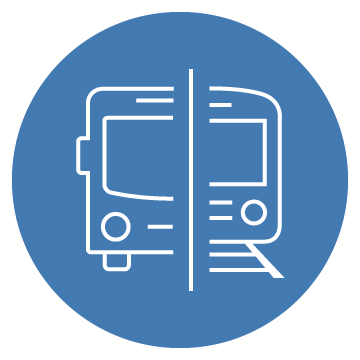
FISCAL
The 2024 Benefits of Transit report (opens in new window) found that:
- Land and buildings near Metro stations generate around $3.2 billion in property tax revenues annually.
- Metro stations have twice as many businesses, three times more jobs, and three times more property value than areas without Metro.
- Over half of the region’s 240,000 businesses—and more than 70% of its 2.5 million jobs—are within a half-mile of a Metro rail station or bus stop.
- Without transit, the region would lose more than $9 billion worth of economic activity and business output due to heavy traffic congestion, lack of access to jobs, and much slower movement of goods.
Additionally, Metro reduces total household expenses by reducing transportation costs. Households can save money on both the cost of vehicle operation and car ownership by living close to a Metro station. Metro estimates that the annual savings for families living near Metrorail station and/or bus corridors is $342M annually.

ENVIRONMENTAL
TOD is good for the environment. Households and employees adjacent to transit are more likely to use transit, resulting in reduced auto use and lower GHG emissions. In certain areas, building TODs can actually reduce driving by up to 85%.
By 2025, transit will keep about 1.2 million cars off the road every day. Lined up in a row, those cars would stretch from Washington, DC to Alaska. Additionally, Metro estimates that transit avoids an additional 1.2 million metric tons of greenhouse gases each year. That’s the same as if all the households in Arlington, VA didn't use energy for an entire year

Household Savings and Quality of Life
TOD creates accessible neighborhoods with amenities that can lead to reduced car ownership. Car ownership costs about $12,000 a year on average. The average cost of a monthly Metro pass is $1,500 a year, so transit saves no-or-car-lite households $10,500 per year. Transit riders save about $2,800 a year by not having to pay for rideshares, taxis, parking, and tolls, too.
Because transit is also 20 times safer than driving a car, transit also improves health. People who ride transit walk as much as 30 minutes more a day, increasing heart health, building muscle, and reducing risk of heart disease, Type 2 diabetes, and some cancers.

ECONOMIC
According to WMATA’s Making the Case for Transit: WMATA Regional Benefits of Transit report, Metro supported over 10,970 jobs and estimated nearly 15,000 additional jobs associated with Metro operations in 2010. WMATA also looked at the impacts of new Metrorail stations on employment and the local economy. For example, after the NoMa Station opened in 2004, WMATA found that 15,000 jobs were created within the 35-block area around the station between 2001 and 2007. Additionally, property values rose significantly in the same area, from $535 million in 2001 to $2.3 billion in 2007.
WMATA found that, overall, being within close proximity to transit had a positive impact on property values for single and multi-family residential and office developments. This, in turn, allows jurisdictions to collect additional revenue in the form of property taxes to fund schools and public services from properties adjacent to transit.